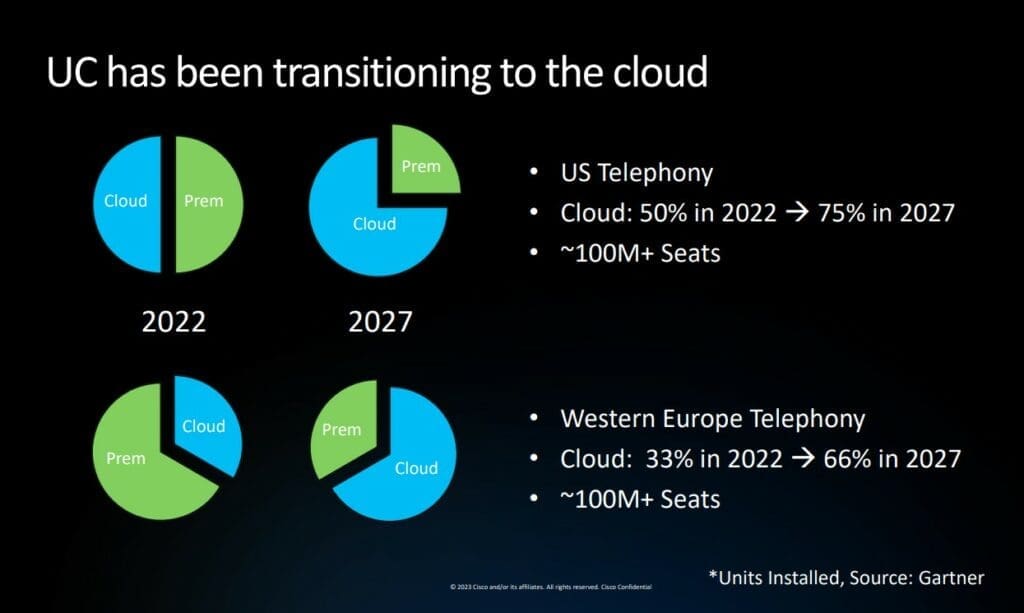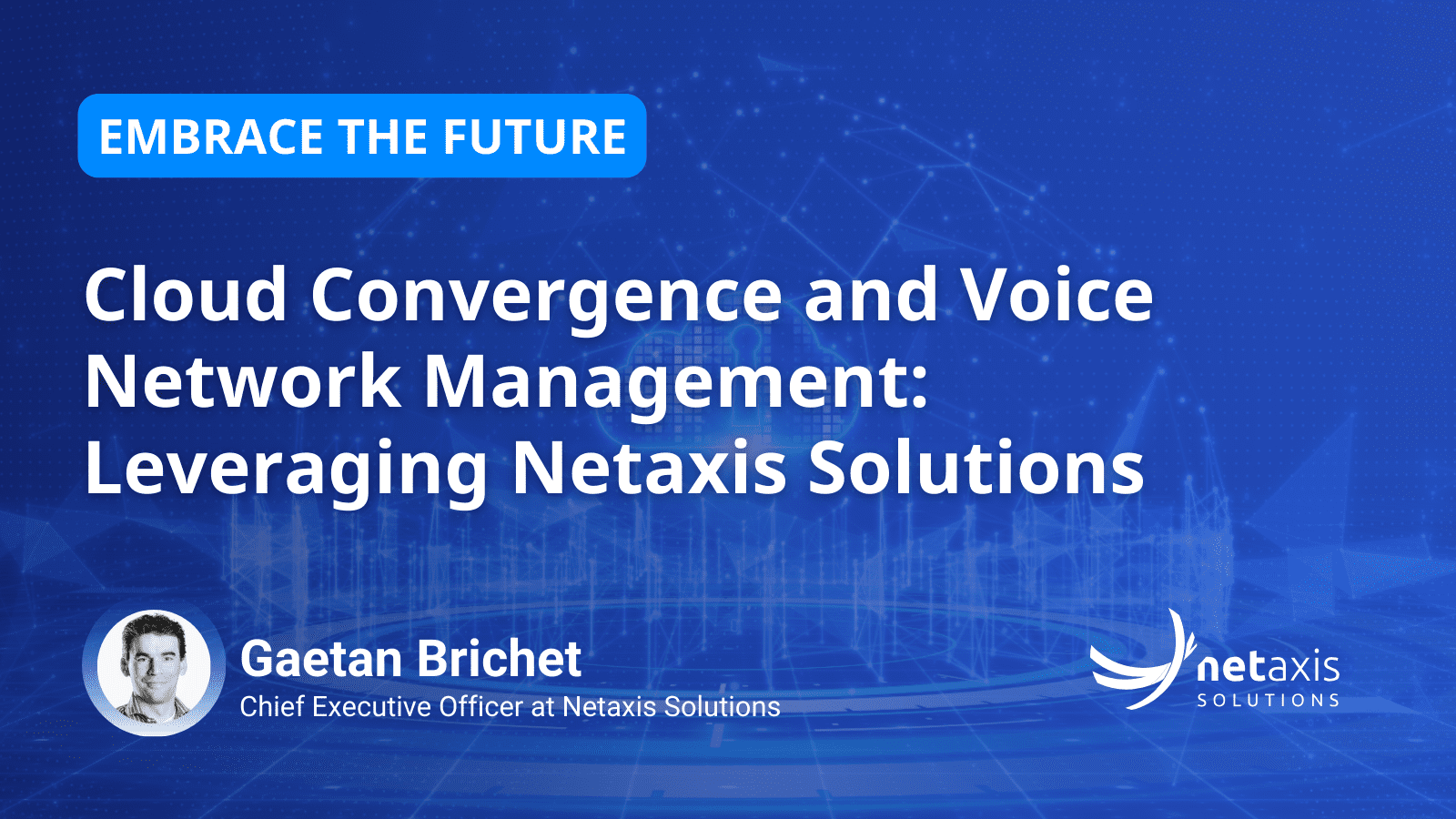The transition of Voice Communications to rich cloud UC (unified communications) environments is a significant trend in the telecommunications industry. A clear shift from on-premises solutions to cloud-based platforms is occurring, forecasting a considerable increase in cloud adoption for US and Western Europe telephony services by 2027.

The challenges
The challenges faced by telecoms operators in the transition to cloud-based Unified Communications (UC) systems and the management of voice networks are multifaceted and must be addressed to remain competitive, ensure service quality, and meet evolving customer demands. Here are some of these challenges:
- Integration complexity: Traditional voice networks and newer cloud-based UC platforms often have different protocols and interfaces. Integrating these systems requires a sophisticated approach to ensure seamless connectivity. Failure to do so can lead to service disruptions, poor call quality, and ultimately, customer dissatisfaction.
- Quality of service (QoS): Voice traffic is sensitive to latency, jitter, and packet loss. As services move to the cloud, maintaining high-quality voice communication becomes challenging. Operators need to ensure their network infrastructure can handle the increased demand for bandwidth and provide consistent QoS.
- Interoperability: There are numerous UC platforms and applications in the market, and not all of them work well together. Service providers need to ensure that their offerings are compatible with a wide range of other services and devices to avoid limiting their customers’ choices.
- Security and compliance: With the proliferation of cyber threats and stringent regulatory requirements, operators must secure their networks and ensure compliance with local and international standards. Cloud environments introduce new vulnerabilities and compliance challenges that need to be managed effectively.
- Scalability and flexibility: Customer needs are constantly changing, and the ability to scale services up or down quickly is vital. The cloud offers this scalability, but it requires operators to have flexible management systems that can adapt to changing demands without incurring significant costs.
- Operational efficiency: Managing and monitoring a mix of on-premise and cloud-based services increases operational complexity. Operators need tools that can automate routine tasks, provide real-time analytics, and enable quick troubleshooting to enhance operational efficiency.
- Cost management: Migrating to the cloud can be expensive, and operators must manage these costs carefully to maintain profitability. This includes the cost of new hardware, software licenses, training for staff, and ongoing maintenance.
- Customer experience: As the touchpoint for numerous services, UC platforms must deliver a seamless user experience. Any failure can lead to a loss of customers to competitors. Operators need to address these expectations with consistent and user-friendly services.
Addressing these challenges is essential for operators because:
- Customer retention and growth: Satisfying customer demands with reliable, high-quality services encourages loyalty and attracts new customers.
- Competitive advantage: Operators that can efficiently manage the complexities of modern UC systems can differentiate themselves from competitors.
- Revenue opportunities: By ensuring interoperability and high service quality, operators can explore new business models and revenue streams, such as offering UC as a Service (UCaaS).
- Innovation: Addressing these challenges often leads to innovation, helping operators to stay ahead in a rapidly evolving technological landscape.
- Regulatory compliance: Operators must comply with regulations to avoid fines and reputational damage.
Enabling platforms become key in this transition
Managing voice networks while migrating to the cloud and dealing with the proliferation of multiple UC solutions poses several challenges. Service providers must ensure seamless integration, maintain quality of service, and handle complex routing of voice traffic, all while aiming for cost-efficiency.
Netaxis offers innovative solutions that address these challenges:
- APIO – API Orchestrator & SRE – Session Routing Engine: This platform enables service providers to create new user experiences through simplified, white-labelled portals that are customizable according to market and customer needs. It provides graphical programmable orchestration, which is a form of flow-based programming, to enhance flexibility in services. Both platforms facilitate the integration of service providers’ Operational Support Systems (OSS) and Business Support Systems (BSS). This can often be a technically challenging and time-consuming task, but SRE aims to streamline it, allowing for quicker deployment and monetization of services.
- Netaxis Fusion: This solution assists service providers in solving complex problems related to interoperability and convergence. It’s designed to transform the user experience for UCC (Unified Communications and Collaboration) customers, delivering services more rapidly through process automation and self-service portals. It also promises seamless integration with multi-vendor support for Session Border Controllers (SBCs) and UCC platforms, reducing operational complexity and saving costs.
By utilizing these solutions, telecoms operators can turn today’s challenges into opportunities for the future. APIO’s ability to manage diverse network elements and user interfaces, SRE’s efficient call routing, and Fusion’s promise of interoperability and streamlined operations can collectively provide a cost-effective network management strategy.

These solutions are particularly relevant when considering the projected increase in cloud-based UC services, as they offer ways to manage the transition effectively. By ensuring call traffic stays on the network and providing high-quality and reliable features, Netaxis solutions like APIO and SRE can help maintain and even increase Average Revenue Per User (ARPU), which is vital as the industry moves towards greater cloud adoption.
In conclusion, as the industry transitions more towards cloud-based solutions, the tools provided by Netaxis are instrumental for telecoms in managing their networks efficiently, ensuring quality service, and opening up new revenue streams while navigating the complexities of modern UC ecosystems.





